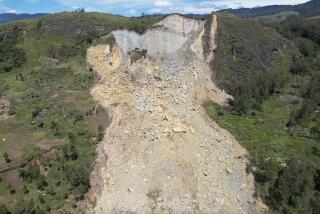South Pacific Tidal Wave Kills Scores
- Share via
PORT MORESBY, Papua New Guinea — A 23-foot-high tidal wave crashed into the northern coast of Papua New Guinea, washing away villages built on beaches, killing at least 71 people and leaving hundreds missing, disaster officials said Saturday.
Thousands were without food and shelter after the wave hit the southwest Pacific island group Friday night after a magnitude 7 earthquake about 12 miles offshore, the National Disaster Center said.
While authorities have put the death toll at 71, there were unconfirmed reports that dozens more may have been killed by the wall of water, called a tsunami because it was caused by an earthquake.
The Papua New Guinea Defense Force was on standby today, and police and health services officials expected the death toll to rise.
“We expect that about 3,000 people have been made homeless, and there has been an estimate of about 300 people dead or missing,” Austen Crapp, a relief organizer, told the Australian Broadcasting Corp.
Most of the dead were children who drowned, he said.
The tsunami struck west of the town of Aitape in the West Sepik province, hitting at least four villages--Sissano, Warapu, Arop and Malol, disaster officials said.
The area is spotted with villages consisting of homes built on beaches of jungle materials.
“At Warapu, there is no house standing--it’s a village of 1,800 people,” Crapp said. “Arop, again, is 1,800 to 2,000 people--there’s nothing standing there.
“They are both clean sand. It’s complete devastation,” he said.
*
A helicopter pilot who landed in Aitape on Saturday reported seeing bodies floating in the lagoon, Crapp said.
Papua New Guinea, with a population of 4 million, is largely dependent on agriculture and mining. The capital, Port Moresby, is about 375 miles east of Australia’s northeast tip.
The country’s provincial disaster coordinator, Peter Tavun, said homeless survivors were in desperate need of food and shelter.
A helicopter was picking up injured people, and doctors had been flown in to treat them. Most of the injured were suffering from cuts and fractures.
Australia said it will provide transport for relief supplies and a mobile hospital to Papua New Guinea.
More to Read
Sign up for Essential California
The most important California stories and recommendations in your inbox every morning.
You may occasionally receive promotional content from the Los Angeles Times.













